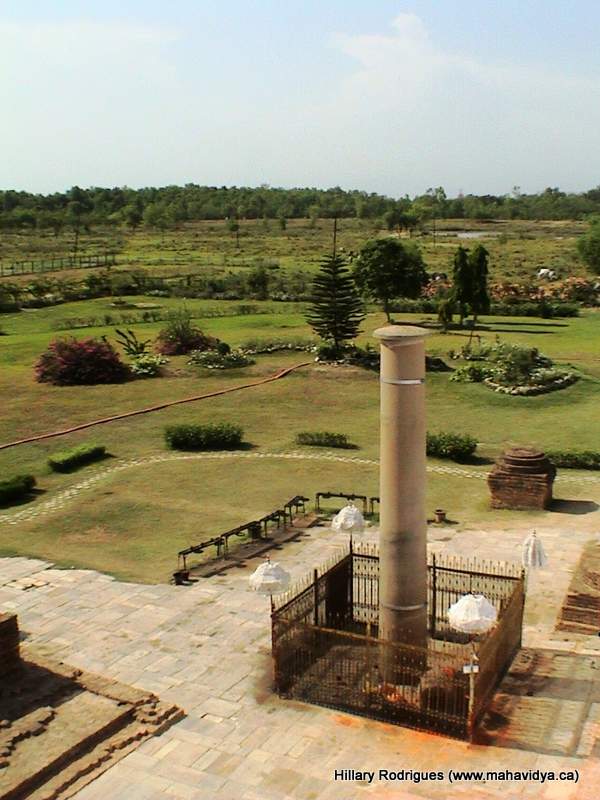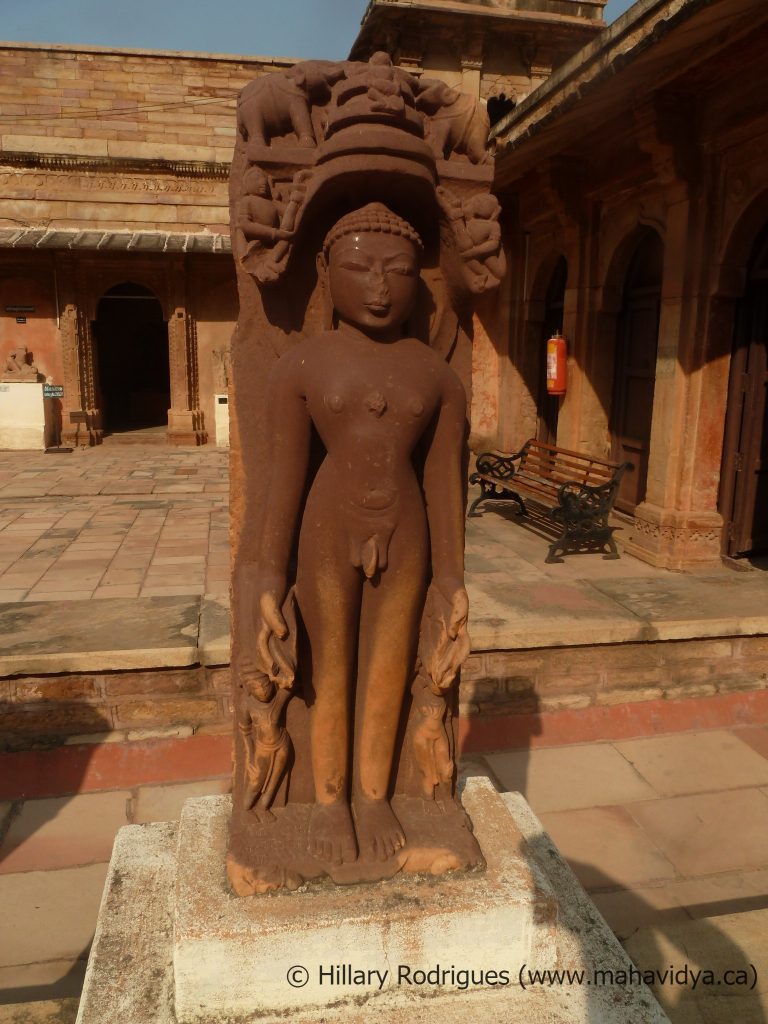Shi Faxian wrote a detailed record of his travels from the years 399-418 C.E. after noticing that the Vinaya-Pitaka, a collection of Buddhist scripture, was unfinished, particularly, the Vinaya concerning monastic rules and precepts (Li, 157). Without this knowledge, those who wished to renounce and live religious life according to the Buddha’s teaching did not have the resources to do so. A completed Vinaya would provide monks or bhiksus with rules, daily activities and bhiksus ordination ceremonies. Faxian’s travels documented these rituals at the historical time that they happened. Through the culture and customs of the people he met. His major work is the translation of the Maha-samghika-Vinaya with the help of Buddhabhadra along with the recovery of the Sanskrit text Mahisasaka-Vinaya. Several pieces of his work appear in the collections of the Tripitaka (Li, 159).
Faxian was originally named Kung but was sent to the Buddhist order at the age of three. There, he was given the religious name of Fa-hsien meaning, “Law Manifest” (Fa-hsien, 7). Fa-hsien departed from Chang-an in the year 399 C.E. at the age of sixty-five. The list of places he visited is numerous, starting from dangerous deserts to powerful kingdoms to a three-year long return voyage. He crossed deserts, the Pamir Plateau, travelled through North, Central and East India, then sailed across the Indian Ocean and the China sea, landed at Laoshan and reached Chienkang in 413 C.E. (Fa-hsien, 7). By the time he returned to China he was seventy-four years old. Before his travels, Chinese monks had yet to travel further than North India. When Fa-hsien arrived in North India, sutras were passed down orally which convinced Fa-hsien to press further into India in pursuit of monastic rules that Chinese monks deeply needed. These monastic rules are one of three main parts of the Tripitaka. The Sutra-Pitaka, contains the sayings of Buddha and his main disciples, the Vinaya-Pitaka contains Monastic rules and the Abhidharma-pikaka is known as the Basket of Commentaries (Fa-hsien, 15).
Fa-hsien’s first stop travelling west was the country of King Ju Tan where he would stay for his first summer retreat. It was a Buddhist custom for monks to take the summer or rainy days off. From there Fa-hsien would travel to Tunhaung after his summer retreat through a desert that was known to have evil spirits and hot winds that killed every man who encountered them. It was described to have skeletons of those who perished there to mark the way (Fa-hsien, 16). He visited the Country of Shenshen and Agni. Both Kings in these countries embraced Buddhism and had four thousand monks from the Hinayana School. Agni held monks who held traditions far more strictly than Shenshen and who prohibited Chinese Monks (Fa-hsien, 17). The Country of Khotan was largely prosperous and hospitable. Here they witnessed the image procession. Travelling to Khalacha, Fa-hsien witnessed the five-year assembly, a time in which the king presents offerings to monks. From Khalacha, the group journeyed west to North India where they crossed the Pamirs. (Fa-hsien, 18-22).
They arrived in Udyana, the northernmost part of India and found all the inhabitants to speak the language of Central India. Here it was rumoured that Buddha came to this country when he visited North India. After a summer retreat they travelled south to Suvastu, it is said that the king tested Buddha by transforming into a hawk and a dove. To ransom for the dove the Buddha cut off a piece of his flesh for the hawk (Fa-hsien, 26). Travelling East, the places they visited had many claims to former actions of the Buddha. He gave up his body for alms, his eyes in Gandhara and head in Takshasila. Travelling south the group eventually reached the city of Hilo where there was built a temple for Buddha’s skull. Here, the king worried about security assigned eight men of noble families each with a seal to seal up the relic. Every morning they would check to see if the seals were broken or tampered with. Fa-hsien would go on to lose a companion to the cold of the Lesser Snow Mountains (Fa-hsien, 28-34). Eventually, they reached Central India, also known as the Middle Kingdom. It is here that Fa-hsien would acquire the Maha-samghika-Vinaya. He also obtained the Sarvastivada-Vinaya (Li, 202).
Having arrived in Central India, they arrived at a country called Samkasya where Buddha descended from the Trayastrimsas Heaven after preaching the Law to his mother for three months. To the southeast, Kanyakubja was a city in which the Buddha taught the law to his disciples. Further on, the Country of Vaisakha where the Buddha planted a willow twig that he used to clean his teeth with. Heretical Brahmans would cut it down, but it would spring up in the same place as before. Northward to the City of Sravasti was a city that was scarcely populated. Southeast from here laid the city of Kapilavastu and the garden of Lumbini. Here, the Krakuchchanda Buddha was born while in the garden of Lumbini, the queen bathed in a pool. When she emerged she gave birth to a son who would be bathed by two dragon-kings. A well was made there where the monks would usually drink from. (Fa-hsien, 49). East of this is the country of Ramagrama, known for its relics. Further east they reached the city of Kushinagara, where the Buddha was said to have entered Nirvana. East, they reached the country of Vaisali, north of which is the storeyed Monastery where the Buddha lived. Eventually, they reached the country of Magadha and the city of Pataliputra which was King Asoka’s capital (Fa-hsien, 50-58). King Asoka (272-232 B.C.E.) was king during Buddhism’s spread to Asia. Heading west they arrived at the new city of Rajagriha which was mentioned to only have two monasteries (Fa-hsien, 62). Passing through the Gridhrakuta Mountain, where the Buddha used to sit in meditation at the summit, they reached the city of Gaya. This city, unfortunately, was deserted. Fa-hsien returned to Pataliputra and travelled west to reach the city of Varanasi, a short distance away to the deer park where Pratyka Buddha entered Nirvana. Fa-hsien ended his journey in central India in the country of Tamralipti where he spent three years on a voyage to Chang-an (Fa-hsien, 63-72).
Fa-hsien’s main purpose in travelling west was to obtain monastic rules in India. He travelled to India during the reign of King Chandragupta II. His account of his travels, the Record of Buddhist Countries is the earliest account of information that we have of this era besides a few coins and sculptures (Fa-hsien, 9). The places that he names are of great interest to those studying the trade routes between China and the west. One of the earliest cultural interactions noted during his time in Shenshen, was that the monks residing there all practised the religion of India, but some observed it more strictly than others. This was how it was visiting countries to the west. It was only the language that differed from country to country. One of the earliest recordings of a cultural event was the record of the image procession in the country of Khotan. The image procession has a resemblance to that of a parade. It begins on the first day of the fourth month with the cleaning of the streets. The monks that the king has favour (during this time it was the monks of Gomati Monastery) would prepare a four-wheel image car three li from the city. This image was adorned with precious substances such as gold, silver, lapis-lazuli etc. Buddha’s image would stand at the centre of the car attended by two Bodhisattvas while divas of gold, silver or carved jade are suspended in the air. When the car approached the city, the king would take off his crown and change into clean clothes. Then, carrying flowers would burn incense before them. There is a different car for each ceremonial and each monastery had one day to parade its images (Fa-hsien, 19).
During Fa-hsien’s time in Central India, he was able to acquire a copy of the Maha-samghika-Vinaya. The translation of this text would be his major contribution to Chinese Buddhism and the understanding of monastic rules. It was the most extensive and complete text of the Vinaya (Li, 202). First arriving in Central India he took the time to describe the environment. The customs of the region were that people were rich and contented and unaffected by any poll-tax or official restrictions. Only those who farmed on the land owned by the king would pay a land tax and they were completely free to go and come as they pleased. The king governed without resorting to capital punishment, but criminals were punished via fines according to their crimes. Those who committed high treason (a crime of the highest degree) would have their right hand cut off. The residents of this country did not kill living creatures, drink wine or eat onion or garlic. Although those with the title of, “chandalas” or “evil men” did. Chandalas would enter the town by announcing their presence by hitting a piece of wood. These people held the occupation of fishermen or hunters. The monks were lavishly treated by the king and devoted themselves to reciting scriptures or sitting in meditation. When a travelling monk arrived, they carried their robe and alms-bowl (Fa-hsien, 36).
Faxian’s records of his travels have undoubtedly played a key part in introducing a further understanding of Buddhism and Hinduism to the Chinese culture. From a country rich in Buddhists and poor in monastic understanding, it would be Faxian who would venture out further than North India into Central India where he would obtain and translate the Maha-samghika-Vinaya and bring back the Sanskirt text of Mahisasaka-Vinaya as well as numerous other Vinaya texts unknown to China. His journey was, therefore, a huge success. The list of counties that he travelled to were extensive and each country had its own story to tell. In the Northern parts of India, the countries all practiced religion but in different languages. Central India came with stories and claims of the Buddha’s travels through Central India. All of these can be considered to get a glimpse of what life was like in the fifth century.
REFERENCES AND FURTHER RECOMMENDATED READING
Waugh, Daniel (1999) “The Journey of Faxian to India.” The University of Washington. Accessed January 29, 2020. https://depts.washington.edu/silkroad/texts/faxian.html.
Li, J., and Dalia A. A. (2002) Lives of great monks and nuns. Berkeley: Calif. Numata Center for Buddhist Translation and Research.
Fa-hsien., and Li Yung-hsi (1957) A Record of the Buddhist Countries. Peking: Chinese Buddhist Association.
Related Topics for Further Investigation.
Vinaya-Pitaka
Monastic rule
Monks
Bhikshus
Mahasamghika-vinaya
Sanskrit
Mahisaska-vinaya
Tripitaka
Central India
Middle Kingdom
Buddhism in China
Sehi
Fa-hsien
Noteworthy Websites Related to the Topic.
https://depts.washington.edu/silkroad/texts/faxian.html
https://www.britannica.com/biography/Faxian
https://academic-eb-com.ezproxy.uleth.ca/levels/collegiate/article/Faxian/33506
https://search-credoreference-com.ezproxy.uleth.ca/content/entry/prdb/faxian/0
Article written by: Bennett Kubitz (February 2020), who is solely responsible for its content.


